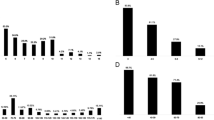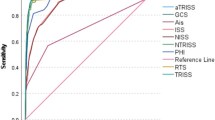Abstract
Purpose
We evaluated the predictive ability of mechanism, Glasgow coma scale, age and arterial pressure (MGAP), Glasgow coma scale, age and systolic blood pressure (GAP), and triage-revised trauma Score (T-RTS) scores in patients from the Spanish trauma ICU registry using the trauma and injury severity score (TRISS) as a reference standard.
Methods
Patients admitted for traumatic disease in the participating ICU were included. Quantitative data were reported as median [interquartile range (IQR), categorical data as number (percentage)]. Comparisons between groups with quantitative variables and categorical variables were performed using Student’s T Test and Chi Square Test, respectively. We performed receiving operating curves (ROC) and evaluated the area under the curve (AUC) with its 95 % confidence interval (CI). Sensitivity, specificity, positive predictive and negative predictive values and accuracy were evaluated in all the scores. A value of p < 0.05 was considered significant.
Results
The final sample included 1361 trauma ICU patients. Median age was 45 (30–61) years. 1092 patients (80.3 %) were male. Median ISS was 18 (13–26) and median T-RTS was 11 (10–12). Median GAP was 20 (15–22) and median MGAP 24 (20–27). Observed mortality was 17.7 % whilst predicted mortality using TRISS was 16.9 %. The AUC in the scores evaluated was: TRISS 0.897 (95 % CI 0.876–0.918), MGAP 0.860 (95 % CI 0.835–0.886), GAP 0.849 (95 % CI 0.823–0.876) and T-RTS 0.796 (95 % CI 0.762–0.830).
Conclusions
Both MGAP and GAP scores performed better than the T-RTS in the prediction of hospital mortality in Spanish trauma ICU patients. Since these are easy-to-perform scores, they should be incorporated in clinical practice as a triaging tool.

Similar content being viewed by others
References
Haagsma JA, Graetz N, Bolliger I, Naghavi M, Higashi H, Mullany EC, et al. The global burden of injury: incidence, mortality, disability-adjusted life years and time trends from the Global Burden of Disease study 2013. Inj Prev. 2016;22:3–18.
Alberdi F, García I, Atutxa L, Zabarte M. Trauma and Neurointensive Care Work Group of the SEMICYUC. Epidemiology of severe trauma. Med Intensiva. 2014;38:580–8.
MacKenzie EJ, Rivara FP, Jurkovich GJ, Nathens AB, Frey KP, Egleston BL, et al. A national evaluation of the effect of trauma-center care on mortality. N Engl J Med. 2006;354:366–78.
Cameron PA, Gabbe BJ, Smith K, Mitra B. Triaging the right patient to the right place in the shortest time. Br J Anaesth. 2014;113:226–33.
Lefering R. Trauma scoring systems. Curr Opin Crit Care. 2012;18:637–40.
Champion HR, Sacco WJ, Copes WS, Gann DS, Gennarelli TA, Flanagan ME. A revision of the trauma score. J Trauma. 1989;29:623–9.
Boyd CR, Tolson MA, Copes WS. Evaluating trauma care: the TRISS method. Trauma Score and the Injury Severity Score. J Trauma. 1987;27:370–8.
Chico-Fernández M, Llompart-Pou JA, Sánchez-Casado M, Alberdi-Odriozola F, Guerrero-López F, Mayor-García MD et al. En representación del Grupo de Trabajo de Trauma y Neurointensivismo SEMICYUC. Mortality prediction using the TRISS methodology in the Spanish Trauma ICU registry (RETRAUCI). Med Intensiva. 2016. http://dx.doi.org/10.1016/j.medin.2015.11.003
Sartorius D, Le Manach Y, David JS, Rancurel E, Smail N, Thicoïpé M, et al. Mechanism, glasgow coma scale, age, and arterial pressure (MGAP): a new simple prehospital triage score to predict mortality in trauma patients. Crit Care Med. 2010;38:831–7.
Kondo Y, Abe T, Kohshi K, Tokuda Y, Cook EF, Kukita I. Revised trauma scoring system to predict in-hospital mortality in the emergency department: glasgow coma scale, age, and systolic blood pressure score. Crit Care. 2011;15:R191.
Bouzat P, Legrand R, Gillois P, Ageron FX, Brun J, Savary D, et al. TRENAU Group. Prediction of intra-hospital mortality after severe trauma: which pre-hospital score is the most accurate? Injury. 2016;47:14–8.
Ahun E, Köksal Ö, Sığırlı D, Torun G, Dönmez SS, Armağan E. Value of the Glasgow coma scale, age, and arterial blood pressure score for predicting the mortality of major trauma patients presenting to the emergency department. Ulus Travma Acil Cerrahi Derg. 2014;20:241–7.
Hasler RM, Mealing N, Rothen HU, Coslovsky M, Lecky F, Jüni P. Validation and reclassification of MGAP and GAP in hospital settings using data from the Trauma Audit and Research Network. J Trauma Acute Care Surg. 2014;77:757–63.
Martín Quirós A, Borobia Pérez A, Pertejo Fernández A, Pérez Perilla P, Rivera Núñez A, Martínez Virto AM, Quintana Díaz M. [Mortalidad en el traumatismo potencialmente grave atendido en un servicio de urgencias de tercer nivel. Evaluación de la escala pronóstica de mortalidad GAP.] Emergencias 2015; 27:371–4. Spanish.
Chico-Fernández M, Llompart-Pou JA, Guerrero-López F, Sánchez-Casado M, García-Sáez I, Mayor-García MD, et al. En representación del Grupo de Trabajo de Trauma y Neurointensivismo SEMICYUC. Epidemiology of severe trauma in Spain. Registry of trauma in the ICU (RETRAUCI). Pilot phase. Med Intensiva. 2015 Oct 1. pii: S0210-5691(15)00171-0. doi: 10.1016/j.medin.2015.07.011.
Hollis S, Yates DW, Woodford M, Foster P. Standardized comparison of performance indicators in trauma: a new approach to case-mix variation. J Trauma. 1995;38:763–6.
O’Reilly GM, Cameron PA, Jolley DJ. Which patients have missing data? An analysis of missingness in a trauma registry. Injury. 2012;43:1917–23.
Gerdin M, Roy N, Khajanchi M, Kumar V, Dharap S, Felländer-Tsai L, et al. Predicting early mortality in adult trauma patients admitted to three public university hospitals in urban India: a prospective multicentre cohort study. PLoS One. 2014;9:e105606.
Hashmi A, Ibrahim-Zada I, Rhee P, Aziz H, Fain MJ, Friese RS, et al. Predictors of mortality in geriatric trauma patients: a systematic review and meta-analysis. J Trauma Acute Care Surg. 2014;76:894–901.
Min L, Burruss S, Morley E, Mody L, Hiatt JR, Cryer H, et al. A simple clinical risk nomogram to predict mortality-associated geriatric complications in severely injured geriatric patients. J Trauma Acute Care Surg. 2013;74:1125–32.
Chang DC, Bass RR, Cornwell EE. Mackenzie EJ (2008) Undertriage of elderly trauma patients to state-designated trauma centers. Arch Surg. 2008;143:776–81 (discussion 782).
Sasser SM, Hunt RC, Faul M, Sugerman D, Pearson WS, Dulski T, et al; Centers for Disease Control and Prevention (CDC). Guidelines for field triage of injured patients: recommendations of the National Expert Panel on Field Triage, 2011. MMWR Recomm Rep. 2012; 61(RR-1):1–20.
Author information
Authors and Affiliations
Corresponding author
Ethics declarations
Ethics Committee approval for the registry was obtained. The study was performed according to the Declaration of Helsinki Statement.
Conflict of interest
Juan Antonio Llompart-Pou, Mario Chico-Fernández, Marcelino Sánchez-Casado, Ruth Salaberria-Udabe, Cecilia Carbayo-Górriz, Francisco Guerrero-López, Javier González-Robledo, María Ángeles Ballesteros-Sanz, Rubén Herrán-Monge, Lluís Servià-Goixart, Rafael León-López and Estela Val-Jordán declare that they have no conflict of interest.
Funding
RETRAUCI received funding from the Fundación Mutua Madrileña during 3 years for the development of a web-based database Granted to the principal investigator (Dr. Chico-Fernández, AP117892013), on behalf of the GT Trauma y Neurointensivismo SEMICYUC.
Additional information
en representación del Grupo de Trabajo de Trauma y Neurointensivismo SEMICYUC.
The members of the collaborators names are listed in the Appendix.
Appendix
Appendix
Collaborators
Carlos García Fuentes, Luis Terceros Almanza, Susana Bermejo, Carolina Mudarra Reche, Isidro Prieto del Portillo (Hospital Universitario 12 Octubre), Iker García Sáez, Fermín Alberdi Odriozola (Hospital Universitario de Donostia), Javier Homar Ramírez, Jon Pérez Bárcena (Hospital Universitario Son Espases), María Dolores Mayor García (Complejo Hospitalario de Torrecárdenas), Eduardo Miñambres García (Hospital Universitario Marqués de Valdecilla), Juan José Egea Guerrero, María Dolores Freire Aragón, Gloria Rivera Rubiales (Hospital Universitario Virgen del Rocío), Ana Bueno González, Carmen Corcobado Márquez (Hospital General Universitario de Ciudad Real), Juan Francisco Fernández Ortega (Hospital Universitario Carlos Haya), Pedro Enríquez Giraudo, Ana Prieto de Lamo, Ángela González Salamanca, Marta García García (Hospital Universitario Río Hortega), José Roldán Ramírez, Eva Regidor, Juan Ángel Tihista Jiménez (Complejo Hospitalario de Navarra), Lucía López Amor, Lorena Martín Iglesias (Hospital Universitario Central de Asturias), Inés Martínez Arroyo (Hospital Miguel Servet), Manuel Quintana Díaz, Carola Gutiérrez (Hospital Universitario La Paz), María Lourdes Cordero Lorenzana (Complejo Hospitalario Universitario A Coruña), Carolina Sena Pérez (Hospital Universitario Ramón y Cajal), Ana Bueno González (Hospital General de Ciudad Real), Eva Tejerina Álvarez (Hospital Universitario de Getafe), María Inmaculada López Fernández (Hospital Universitario La Princesa), José Higinio de Gea García, María Martínez (Hospital Virgen de la Arrixaca), Margalida Vilar Vicens (Fundación Hospital de Manacor), Laura Claverías, Gerard Moreno, Alejandro Rodríguez, (Hospital Joan XXIII), Ion Santacana González (Policlínica Nuestra Señora del Rosario), José Manuel Jiménez Moragas, Mikel Celaya López, Rocío Monterroso Pintado (Hospital Universitario Puerta del Mar), Luis Marina (Hospital Virgen de la Salud), José María Toboso Casado (Hospital Univ. Germans Trias i Pujol), Ana Tejero Mogena, Ana Vallejo de la Cueva (Hospital Universitario Araba), Ramón Fernández-Cid Bouza (Hospital Mateu Orfila), Carlos López Núñez (Hospital General Obispo Polanco).
Rights and permissions
About this article
Cite this article
Llompart-Pou, J.A., Chico-Fernández, M., Sánchez-Casado, M. et al. Scoring severity in trauma: comparison of prehospital scoring systems in trauma ICU patients. Eur J Trauma Emerg Surg 43, 351–357 (2017). https://doi.org/10.1007/s00068-016-0671-8
Received:
Accepted:
Published:
Issue Date:
DOI: https://doi.org/10.1007/s00068-016-0671-8




